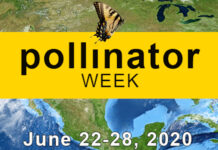By Christine Menapace

As the dangers to monarch populations gain more notoriety, landscapers may see an uptick in clients wanting “butterfly-friendly” plantings and less pesticides in their landscapes. The news on this beautiful, fragile insect isn’t good, but luckily awareness is spreading.
Eastern monarchs, which migrate from southern Canada to central Mexico each fall, actually showed an increase of 144% over last year’s count (its highest in over a decade), but experts are only cautiously optimistic due an overall decline over the past two decades. “This reprieve from bad news on monarchs is thank-you from the butterflies to all the people who planted native milkweeds and switched to organic corn and soy products,” comments Tierra Curry, a senior scientist at the Center for Biological Diversity, which is based in Tucson, AZ. “But one good weather year won’t save the monarch in the long run…”
News on the other coast, however, is dire for the Western monarch. This year’s California overwintering population was less than 0.5% of its historical size, and has declined by 86% compared to 2017, according to preliminary data released from the Xerces Society, located in Portland, OR. Overall, they report, the western monarch population is just .6% of what it was in the 1980s.
While weather conditions and other factors play a role in survival, most experts point to the use of insecticides and loss of habitat as key factors of decline. As a result, conservation organizations are encouraging residents, businesses, and municipalities to incorporate butterfly-friendly plantings in their landscapes. While many attractive flowering perennials provide much needed nectar to fuel the monarch’s long journeys, milkweed is the only plant that monarchs will lay their eggs on.
Milkweed: Sourcing The Right Variety
With over 100 different varieties of milkweed, it’s best to plant those native to your business region. Tropical milkweed, for instance, can cause problems with a protozoan parasite of monarchs called Ophryocystis elektroscirrha (or OE) when introduced in a temperate area where it does not die back in winter. Typically, when native milkweed dies back after blooming, the parasite dies along with it. In this way, each summer’s monarch population feeds on fresh, parasite-free foliage. But with tropical milkweed, the OE levels can build up to dangerous levels for monarchs when it lives through the winter.
To find the right variety of milkweed, check out the Milkweed Market at monarchwatch.org. MonarchWatch only ships plants to the eco-region from which the seeds originated. Free milkweed is available for large scale restoration projects or plugs can be purchased in unmixed flats of 32 plants for $74 including shipping. (Texas and Oklahoma plants come in flats of 50 and cost $93.50) Don’t need a whole flat? There’s also a helpful list of Milkweed Market Vendors throughout the country.
The Xerces Society is also a source for finding milkweed. It’s redoubling its efforts in initiatives like Project Milkweed and the Milkweed Seed Finder. In collaboration with the native seed industry, the USDA-NRCS Plant Materials Program, and community partners, Xerces is producing new sources of seed in areas of the monarch’s breeding range where milkweed has not been reliably available: California, the Great Basin, Arizona, New Mexico, Texas, and Florida. Check out their Milkweed Seed Finder Map of nurseries at http://xerces.org/milkweed-seed-finder/.
Establishing Milkweed & Nectar Plants
Unfortunately, milkweed can be notoriously hard to transplant. One way to establish it is through fall seeding. Sow seeds directly into a mulched bed in the fall and they should germinate by spring. If seeds need to be stored for any time, keep them in an airtight container in a dry and cool environment. (Seeds of milkweed from northern areas will require cold stratification.) If possible, start seeds indoors if you have grow lights or a greenhouse and plant after the last frost. (For full recommendations on seed starting, see https://monarchlab.org/biology-and-research/monarch-rearing/finding-collecting-and-growing-milkweed/ or https://monarchwatch.org/milkweed/prop.htm)
Beyond milkweed, landscapers can incorporate plants that provide nectar for monarchs, bees and hummingbirds, and serve as host plants for eggs of other butterflies. These plants prefer full sun and variety is key. Ensure plants are not treated with systemic insecticides or any other pesticides and continue to keep the garden area free of insecticides, herbicides and fungicides. While the list of pollinator friendly plants is long, Monarch Watch considers the following the “must haves” since they are easy to find and grow:
Asters * Bronze fennel * Butterfly weed * Pearly everlasting * Spicebush * Wild blue indigo * Wild senna * Blueberry * Candytuft * Chives * Eastern red columbine * Foxglove beardtongue * Lilac * Lyreleaf sage * Pincushion flower * Pinks (Sweet William) * Wild blue phlox * Wild petunia * Anise Hyssop * Blue Mistflower * Blue vervain * Borage * Butterfly bush * Cardinalflower * Joe-Pye weed * Lantana * Mexican sunflower * Mountainmint * New York ironweed * Purple coneflower * Salvia ‘indigo spires’ * Spotted beebalm * Texas sage * Wild bergamot * Zinnia * Chrysanthemums * New England aster * Sedum. (For plants suitable for Texas, see the Texas Plant List on monarchwatch.org.)
Additional elements that can be added to the garden which will attract butterflies include: places that provide shelter from wind and rain; dark stones or tiles for warming up; and wet, sandy, or muddy spots to imbibe salts and other nutrients.
Menapace is a professional freelance writer and editor with over 25 years of experience in publishing, journalism, copywriting, and marketing.











![[VIDEO] Dickies®: Discover Workwear That’s Anything But Uniform](https://turfmagazine.com/wp-content/uploads/2023/06/1647663814-4b1a2a7742790a9b1e97a3b963477850192e1d6a9dfba9b07214a77bae25d6e3-d-218x150.jpg)




























![[VIDEO] Dickies®: Discover Workwear That’s Anything But Uniform](https://turfmagazine.com/wp-content/uploads/2023/06/1647663814-4b1a2a7742790a9b1e97a3b963477850192e1d6a9dfba9b07214a77bae25d6e3-d-324x160.jpg)